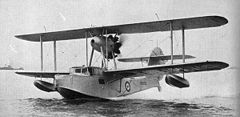Supermarine

| |
| Państwo | |
|---|---|
| Siedziba | |
| Data założenia |
1913 (Pemberton-Billing Ltd.) |
| Data likwidacji |
1960 |




Supermarine Aviation Works Ltd. – dawna brytyjska wytwórnia lotnicza z siedzibą w Woolston, w Southampton. Wśród produkowanych przez przedsiębiorstwo maszyn znajdowały się liczne wodnosamoloty oraz słynny myśliwiec Spitfire[1]. Założona w 1914 roku pod nazwą Pemberton-Billing, przyjęła nazwę Supermarine w 1916 roku. W 1938 roku została oddziałem koncernu Vickers-Armstrongs, jako Vickers-Armstrongs Supermarine.
Historia
[edytuj | edytuj kod]Przedsiębiorstwo zostało założone 27 czerwca 1914 roku[2] pod nazwą Pemberton-Billing Ltd. przez Noela Pembertona Billinga. Pierwotnym zainteresowaniem firmy była budowa łodzi latających, dlatego też już w październiku 1913 Billing zarejestrował adres telegraficzny spółki „Supermarine”, kojarzący się z marynarką[2]. Zakłady zlokalizowano w Woolston nad rzeką Itchen (później część Southampton)[2]. Pierwszą konstrukcją była łódź latająca Pemberton-Billing P.B.1 z 1914 roku, lecz okazała się nieudana i nie wzleciała[2]. Podczas I wojny światowej przedsiębiorstwo zajmowało się głównie remontami samolotów i pracami doświadczalnymi[2]. W 1916 roku Pemberton Billing przeszedł do polityki i sprzedał firmę, która przyjęła nazwę Supermarine Aviation Works Ltd. Dyrektorem zarządzającym został Hubert Scott-Paine, a do firmy dołączył utalentowany konstruktor Reginald Mitchell[2]. Spółka z sukcesem zaczęła konstruować lekkie i cięższe łodzie latające (najbardziej znana Supermarine Walrus), a także szybkie wodnosamoloty dla celów wyścigów lotniczych Schneider Trophy, w których zwyciężały w latach 1927–1931, ostatecznie prowadząc do zdobycia trofeum przez Wielką Brytanię na własność (najbardziej znany Supermarine S.6B)[3]. Wykorzystując doświadczenia z szybkich wodnosamolotów, przedsiębiorstwo zajęło się również jednosilnikowymi myśliwcami, konstruując w 1936 roku swój najsłynniejszy samolot Supermarine Spitfire, produkowany przez cały okres II wojny światowej[3].
W 1928 roku przedsiębiorstwo zostało nabyte przez spółkę Vickers-Armstrongs, a jego nazwa została zmieniona na Supermarine Aviation Works (Vickers) Ltd. Po reorganizacji spółki przeprowadzonej w 1938 roku, zakłady Supermarine (Supermarine Works) utraciły samodzielność i stały się oddziałem Vickers-Armstrongs (Aircraft) Ltd. Dla produkowanych samolotów stosowano nazwę Vickers-Armstrongs Supermarine[4]. Marka Supermarine zniknęła po przejęciu sekcji lotniczej Vickersa-Armstronga przez British Aircraft Corporation (BAC)[5].
Lista produkowanych samolotów
[edytuj | edytuj kod]- Pemberton-Billing P.B.1 (1914)
- Pemberton-Billing P.B.9
- Pemberton-Billing P.B.23
- Pemberton-Billing P.B.25 (1915)
- Pemberton-Billing P.B.29
- AD Flying Boat (1916)
- AD Navyplane (1916)
- Supermarine Nighthawk (1917)
- Supermarine Baby (1917)
- Supermarine Sea Lion I (1919)
- Supermarine Sea Lion II/III (1922)
- Supermarine Channel (1919)
- Supermarine Scylla
- Supermarine Sea Urchin
- Supermarine Commercial Amphibian (1920)
- Supermarine Sea King (1920)
- Supermarine Seagull (1921)
- Supermarine Seal (1921)
- Supermarine Sea Eagle (1923)
- Supermarine Scarab (1924)
- Supermarine Sheldrake
- Supermarine Swan (1924)
- Supermarine Sparrow (1924)
- Supermarine Southampton (1925)
- Supermarine S.4 (1925)
- Supermarine S.5 (1927)
- Supermarine Nanok (1927)
- Supermarine Solent (1927)
- Supermarine Seamew (1928)
- Supermarine S.6 (1929)
- Supermarine S.6B (1931)
- Supermarine Air Yacht (1931)
- Supermarine Type 179 (1931)
- Supermarine Scapa (1932)
- Supermarine Stranraer (1932)
- Supermarine Walrus (1933)
- Supermarine Type 224 (1934)
- Supermarine Spitfire (1936)
- Supermarine Sea Otter (1938)
- Supermarine 322 (1939)
- Supermarine Spiteful (1944)
- Supermarine Seafang (1946)
- Supermarine Attacker (1946)
- Supermarine Seagull (1948)
- Supermarine 510 (1948)
- Supermarine 535 (1950)
- Supermarine Swift (1951)
- Supermarine 508 (1951)
- Supermarine 521 (1950)
- Supermarine 525 (1954)
- Supermarine Scimitar (1956)
Przypisy
[edytuj | edytuj kod]- ↑ Spitfire miracle which helped win the Battle of Britain. BBC News, 2010-08-12. [dostęp 2013-09-03]. (ang.).
- ↑ a b c d e f Birtles 1992 ↓, s. 8.
- ↑ a b Birtles 1992 ↓, s. 10-13.
- ↑ David Brown: Supermarine Walrus and Seagull variants, seria Aircraft Profile Nr. 224, Profile Publications Ltd, Londyn 1971, s.27 (ang.)
- ↑ Records of the British Aviation Industry In the RAF Museum: A Brief Guide. RAF Museum. s. 12-15. [dostęp 2013-09-03]. (ang.).
Bibliografia
[edytuj | edytuj kod]- Philip Birtles: Supermarine Attacker, Swift and Scimitar. Londyn: Ian Allan Ltd., 1992, seria: Postwar Military Aircraft. No.7. ISBN 0-7110-2034-5. (ang.).
Text is available under the CC BY-SA 4.0 license; additional terms may apply.
Images, videos and audio are available under their respective licenses.
